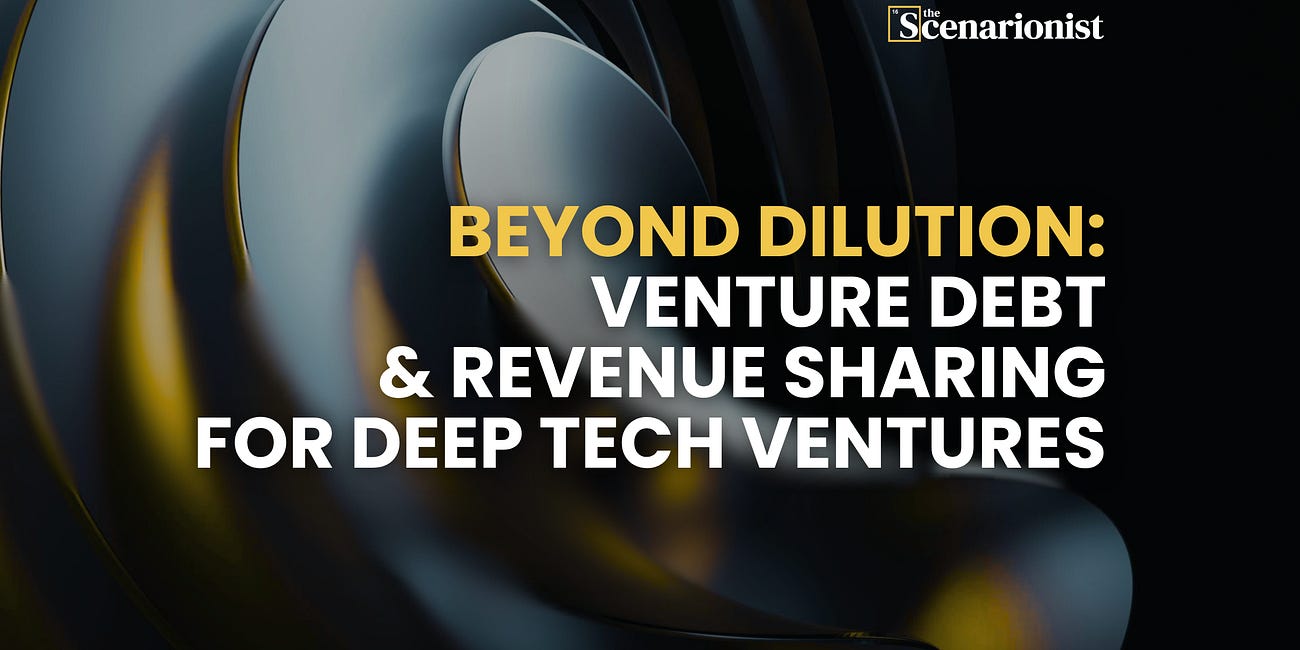Welcome to the 96th edition of Deep Tech Catalyst, the educational channel from The Scenarionist where science meets venture!
Food technology sits at a pivotal point in the Deep Tech landscape. Once confined to the lab, it now stands on the edge of large-scale commercialization, with founders racing to translate scientific breakthroughs into viable products that can transform the global food system.
But will these companies be able to scale at the right speed?
To unpack what it really takes to cross that threshold—from de-risked science to market-ready scale—we’re joined by Steve Molino, Principal at Synthesis Capital.
Key takeaways from the episode (TL;DR):
🌱 Series A is the inflection point
- The shift from proving the science to proving the business.
- Technology must be de-risked, with a credible path to scale.
📈 Conviction without revenue is possible
- Investors look for validated pain points, not just LOIs.
- Demand has to be tied to supply stability, nutrition, or cost—not only sustainability.
🏭 B2B dominates early-stage food tech
- Consumer brands require entirely different capital and teams.
- Ingredients and platforms play show faster paths to traction.
⚖️ Regulation defines market entry
- Singapore, the U.S., and Australia are leading; Europe is cautious.
- First movers build the framework—fast followers benefit from it.
💡 Capital efficiency is survival
- Use interim markets to generate early revenue.
- Outsource manufacturing before investing in facilities.
✨ For more, see Membership | Deep Tech Briefing | Insights | VC Guides
BEYOND THE CONVERSATION — STRATEGIC INSIGHTS FROM THE EPISODE
Mapping the Alternative Protein Landscape
The alternative protein field is most usefully viewed through two complementary lenses: the technologies that make production possible and the solutions those technologies enable.
On the production side, the dominant modalities are well defined.
Plant-based approaches, and fermentation—whether biomass, precision, or traditional—offer multiple routes to functional proteins and ingredients with different levers for cost and scale. Cultivated methods produce real animal products without raising animals. Molecular farming extends the toolkit by using plants as bioreactors to express target animal proteins. Together, these families set the technical roadmaps and cost curves that determine what can reach the market at viable price points.
Across this landscape, companies tend to fall into two roles.
Some manufacture end products or supply ingredients designed to integrate directly into existing formulations. Others operate as enablers, applying technology to lower costs, shorten time to market, and improve reliability for those producers. The distinction matters because it drives capital intensity, team composition, regulatory exposure, and the milestones that credibly signal readiness for scale.
This piece focuses on the producers and how to scale these companies from Series A onward.
The Series A Shift: From Science to Commercialization in Food Tech
Defining the Transition
The Series A stage marks a structural turning point for companies in alternative proteins and food technology. Before this phase, most efforts revolve around proving that the underlying science works. Teams focus on demonstrating functionality, optimizing lab-scale systems, and validating proof-of-concept data.
At Series A, the focus shifts decisively from scientific feasibility to commercial viability. The central question becomes whether the technology can scale at unit economics that make sense for the market.
For founders, this is the moment when Deep Tech logic meets business discipline. Investors expect a de-risked core technology and a credible plan for transforming it into a repeatable, capital-efficient process. At this point, technical validation alone is no longer sufficient. The company must show that the technology can move beyond R&D and into real production environments without losing quality, consistency, or cost control.
What Investors Expect to See
Across most technology modalities—whether fermentation, cultivated production, or molecular farming—Series A readiness involves demonstrating that the technology can operate under commercially relevant conditions.
This does not necessarily require full-scale production or significant revenue, but it does demand evidence that scaling will not expose unmanageable costs or scientific instability.
Investors look for several forms of validation: repeatable pilot data, cost-down trajectories supported by credible assumptions, and early relationships with prospective customers that reflect authentic interest rather than theoretical enthusiasm. The goal is not perfection but proof of direction—a clear line of sight to viable production at market-appropriate price points.
The Capital Deployment Logic
The capital raised at Series A is typically allocated toward the first wave of commercialization. For some companies, this means expanding pilot facilities or engaging contract manufacturing partners to prove scalability.
For others, it supports regulatory preparation, early product testing with key customers, or building commercial teams capable of navigating supply chains and distribution channels.
This stage also demands sharper operational design. Deep tech companies emerging from pre-seed and seed rounds often maintain research-centric structures, led by scientists and engineers.
As they transition to Series A, organizational focus begins to shift toward production, process optimization, and market entry. This requires building capabilities in operations, quality assurance, and business development—areas often unfamiliar to technical founding teams.
Metrics of Success
Series A, therefore, redefines what success looks like. Earlier rounds are measured by proof of science; Series A is measured by proof of scalability and commercial potential.
Founders must articulate not only how the technology works, but how it becomes a business—how the economics evolve with volume, how regulatory milestones align with market timing, and how the next stage of growth capital will translate into meaningful market entry.
In food tech, where development cycles are long and capital intensity is high, Series A is less a finish line than a pivot point. It marks the beginning of the transition from laboratory promise to industrial reality—the moment when the scientific vision starts to take on the shape of a company.
Beyond Dilution: Venture Debt & Revenue Sharing for Deep Tech Ventures | The Scenarionist
How New Models pairing equity with venture debt and revenue sharing bridge the lab-to-market gap for capital-intensive Deep Tech.
Proving Demand Before Revenue
In segments such as cultivated meat and molecular farming, early commercialization is uncommon due to unresolved technical and regulatory risk. In these cases, the absence of revenue is not disqualifying at Series A, but the bar for demonstrating credible demand shifts. Investors look for evidence that prospective customers recognize a concrete problem the product can solve and are preparing to act when supply becomes available.
Pain Points That Actually Drive Adoption
Signals tied to real, near-term problems carry the most weight. Supply chain stability and price predictability for specific inputs, improvements in nutrition or food safety, and solutions to formulation challenges are the kinds of issues that move purchasing decisions.
Sustainability, while directionally important, does not function as a primary buying trigger. Demand narratives centered solely on environmental benefit tend to be discounted unless paired with a pressing operational or product need.
Letters of intent and similar documents are better than nothing but rarely decisive on their own. Their value depends on specificity and enforceability, both of which are often limited. Agreements that bind counterparties to volumes, pricing frameworks, or timelines are uncommon at this stage, and generic expressions of interest provide little conviction.
What matters more is a paper trail that reflects substantive engagement—technical evaluations, pilot scoping, or procurement planning that aligns with the company’s projected readiness.
Convincing evidence of demand comes from direct customer conversations and the consistent patterns that emerge across them.
In food, true offtake agreements are rare. The most informative diligence explores why a customer would switch, what problem the product resolves, how urgently that problem needs attention, and what price and performance thresholds unlock adoption.
When multiple counterparties independently point to the same bottleneck and confirm that the proposed product meets a defined requirement at a tolerable price, demand moves from hypothetical to credible—even before the first sale occurs.
B2B vs Branded B2C at Series A
In food technology, the distinction between business-to-business and business-to-consumer models is more than a matter of market choice—it defines the entire operating structure of a company.
B2C ventures—such as consumer packaged goods (CPG)—rely on marketing expertise, retail distribution, and sustained investment in brand building.
B2B ventures, by contrast, focus on technological differentiation, ingredient functionality, and integration into existing supply chains. These two paths demand fundamentally different forms of capital, team composition, and execution discipline.
The Economics of CPG Companies
By the time a traditional CPG company raises a Series A, it typically shows between five and ten million dollars in annual revenue, established customer loyalty, and a clear relationship between customer acquisition cost and lifetime value.
Achieving those metrics requires significant time in the market and a consumer-facing team skilled in marketing, retail operations, and channel management.
Deep Tech companies rarely fit that profile. Their pre-Series A phases are dominated by research, pilot trials, and process optimization rather than consumer sales.
As a result, they cannot produce the revenue or customer metrics that consumer investors expect. Attempting to compete directly in this category would force them to build two complex organizations at once—one focused on technology, the other on brand development—stretching capital and talent far beyond what early-stage resources allow.
Why Deep Tech (B2B) Companies Are Different
Deep Tech companies require founders to concentrate capital on process efficiency, yield improvement, and scalability—the levers that ultimately determine long-term competitiveness.
It also aligns the company with established industry buyers who already possess distribution, marketing, and consumer reach.
In this model, the startup’s success depends less on consumer perception and more on measurable performance: cost parity, sensory quality, nutritional profile, and consistency.
Implications for Team Design
The orientation toward B2B also shapes the composition of the team. Rather than consumer marketing specialists, successful Series A companies in this space typically build around scientists, process engineers, and operational leaders who can drive productivity gains and establish reliable manufacturing partnerships.
Commercial hires tend to come later and focus on business development within industry networks rather than retail activation.
This approach does not preclude eventual brand creation, but it defers it until the underlying technology is proven and cost-competitive. At Series A, the path of least friction—and greatest investor interest—runs through B2B positioning, where technological differentiation and process excellence take precedence over storytelling and shelf space.
Regulatory Realities and How They Shape Market Entry
Regulation plays a decisive role in determining how and where food technology companies can commercialize. Some products, particularly those built on plant-based or traditional fermentation methods, fit comfortably within existing frameworks.
Novel technologies—such as cultivated meat or molecular farming—face a different reality. These products are introducing new ingredients and production methods that lack historical precedent in the food system. As a result, they require extensive safety validation and ongoing dialogue with regulators to establish entirely new review pathways. The process involves years of work, substantial financial investment, and, in most cases, early engagement with specialized legal and scientific advisors.
First Movers, Faster Followers
In emerging categories, the first companies to engage with regulators effectively become the architects of the framework. They invest time, data, and capital to educate agencies on their technology and its safety profile. This pioneering role carries strategic visibility but also significant cost. Subsequent entrants, by contrast, benefit from a more defined process and from regulators who are already familiar with the relevant science. As the first generation of cultivated and molecular farming companies secure approvals, later-stage entrants can expect faster reviews and lower compliance costs—a dynamic that increasingly informs how founders plan market timing.
Geography as Part of the GTM Strategy
Regulatory openness varies widely across regions, and geography has become a key element of commercial strategy. The United States has emerged as a leading jurisdiction for cultivated products, and Singapore has been recognized as an early pioneer for regulatory approvals. Australia is following with growing institutional support, while parts of Europe continue to move cautiously, balancing innovation with public perception and food safety concerns.
Timing and Capital Implications
The duration of the approval process varies dramatically depending on the novelty of the technology. Products that align with existing frameworks may reach market readiness within months or a year, while those introducing entirely new production methods often require multiple years of review.
For example, several cultivated meat companies that recently achieved regulatory clearance began their dialogue with agencies as early as the mid-2010s, underscoring the long arc of regulatory engagement in this sector.
Such timelines have direct implications for capital planning. Extended approval cycles require companies to secure financing that can sustain operations for several years without revenue. They also heighten the importance of non-dilutive funding sources—grants, partnerships, or joint development programs—to offset costs and preserve equity.
Managing Long Timelines with Limited Capital
For companies facing multi-year regulatory or technical timelines, capital efficiency becomes an existential skill. The period between early validation and formal approval often stretches far longer than initially planned, forcing founders to balance progress with preservation.
The most resilient teams approach this phase not as a pause before commercialization, but as a structured opportunity to strengthen the business while conserving cash.
Capital during this stage is typically allocated to optimizing production methods, refining yields, and lowering unit costs in preparation for scale. Each incremental improvement compounds value, positioning the company to enter the market with a stronger cost base once approval arrives. At the same time, management must maintain enough financial flexibility to navigate uncertainty—extending runway without stalling momentum.
Interim Markets and Staged Entry
Some companies bridge the gap by targeting adjacent markets that operate under lighter regulatory oversight. A protein developed for infant formula, for example, may take years to clear the required safety review. However, the same ingredient might qualify for sale in the supplement market, where approval processes are shorter and entry barriers lower.
By sequencing markets in this way, a company can generate early revenue, validate product performance, and build brand credibility ahead of its long-term target category.
Others apply their core technology to secondary products that can be commercialized sooner. A process designed for large-scale food production may first be used to manufacture a high-value specialty ingredient. These staged approaches serve dual purposes: they create proof points for investors and help the team refine operations under real market conditions.
Demonstrating traction through cost reduction
For investors, the clearest evidence of progress during this period is movement down the cost curve. In precision fermentation, for example, productivity and yield are key indicators of scalability. A company able to increase titers, improve strain performance, and lower bioprocessing costs demonstrates not only technical competence but also strategic discipline.
An illustrative case comes from a company producing dairy proteins through precision fermentation. The business attracted investor confidence not because of revenue but because its production yields were already leading the field. Its microbial system produced high-quality proteins efficiently enough to make commercialization viable at current price points for a defined segment of the market. As production scales and costs decline, additional customer segments become accessible, expanding the addressable market in step with technical progress.
Scaling through partnerships before internal expansion
At this stage, most food technology startups rely on Contract Manufacturing Organizations (CMOs) rather than building in-house facilities. Partnering with experienced CMOs allows companies to validate tech transfer, confirm production consistency, and reach early customers without incurring the full capital burden of proprietary infrastructure.
Only once demand is proven at a meaningful scale does in-house manufacturing become strategic.
This phased approach—outsourced production first, vertical integration later—aligns technical readiness with commercial reality. It reduces risk, conserves cash, and allows the company to adapt as both market conditions and regulatory environments evolve.
Building Endurance Ahead of Scale
Capital efficiency in deep tech food ventures is not simply about spending less; it is about sequencing intelligently. Each decision—whether to pursue a short-term revenue stream, deepen process optimization, or expand production capacity—must reinforce long-term positioning.
The companies that navigate this phase successfully tend to treat efficiency as a discipline, not a constraint: a deliberate strategy for staying alive long enough to win.
Power-to-compute leads; ADCs raise big; Autonomy stays bounded & more | Deep Tech Capital Movements #40
This week Deals Sector Allocation — Biotech & Health 10; Energy 8; Industrial 5; Cyber & Defense 5; AgTech & Food 3; Space 3; AI & Compute 3; Semis & Quantum 2; Materials & Mobility & Logistics 1.



![How Advanced Materials Exhibit Inverse Correlation in Downturns + Toolkit [Downturn Screening Pack] | The Scenarionist](https://substackcdn.com/image/fetch/$s_!0X7S!,w_140,h_140,c_fill,f_auto,q_auto:good,fl_progressive:steep,g_auto/https%3A%2F%2Fsubstack-post-media.s3.amazonaws.com%2Fpublic%2Fimages%2Fda2ed61e-68a7-4b71-8843-da0f524189dd_2360x1640.png)










